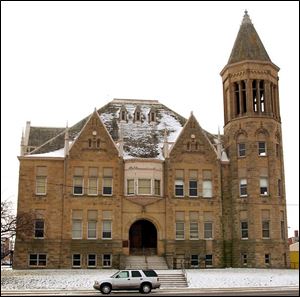
Tiffin school is saved by bell in $75,000 sale
1/24/2004
The sandstone structure, built in 1893, may get a new lease on life as living space or business space or mixed use.
TIFFIN - The former Tiffin Junior High School, a castlelike sandstone structure erected in 1893, could be renovated into apartments, office space, a restaurant, or a combination of those uses, the building s prospective owners said yesterday.
The Tiffin City Schools agreed this week to sell the old classroom building and its 1.2-acre site to HomeLife Companies, Inc., of Delaware, Ohio, and JMM Architects, Inc., of Columbus for $75,000. The deal, which is set to close April 23, saves the downtown landmark from possible demolition.
“I think it s exciting for us that this asset that has been in the community since the 1890s will continue to be an asset in this community,” school Superintendent Denise Callihan said. “I m excited. I m very excited.”
Donald Rankey, Jr., president and chief executive officer of HomeLife, said he and his partners haven t decided how to use the building, which has about 24,000 square feet. It includes two floors of classroom space, a basement, and an attic with a 40-foot arched ceiling.
Options include turning the school into a housing complex or developing it for mixed use, such as a first-floor restaurant with apartments on the second floor and commercial space in the attic, Mr. Rankey said.
“Because of the cost to renovate, we re going to have to get very creative as far as readaptive uses,” he said. “We don t have any concrete plan for it today.”
He said he was attracted to the building on East Market Street by its wide-open spaces and well-preserved interior details, including oak storage cabinets and hardwood maple floors.
“That particular building is in relatively good shape, thanks to you taking good care of it,” he told school officials during a news conference at the Tiffin Area Chamber of Commerce. “The building has been well-preserved.”
During a tour of the school, Mr. Rankey and Mike Milligan, president of JMM, marveled over the intricately designed tin ceilings in the second-floor hallway and the rounded spindles on the pine staircase between the first two floors.
“These spindles, they re just so ornate you can t afford to replace them,” Mr. Rankey said.
HomeLife and JMM collaborated on the renovation of another downtown Tiffin landmark, the former Shawhan Hotel, in the late 1990s. The four-story structure, which was damaged in a 1976 fire and was empty for more than two decades, has been turned into an assisted-living facility with 58 residents and about 60 employees.
The renovation cost $6.5 million.
“Today, it s certainly an asset to the community,” Mayor Bernard Hohman said.
Mr. Milligan said it s unclear how much it would cost to refurbish the former school. He estimated that a basic “cleanup, fix-up renovation” could cost nearly $1 million, adding, “It s not going to be a school, so it s going to be more than a cleanup, fix-up renovation.”
Mr. Hohman said the city receives about $90,000 a year in Community Development Block Grant funds and is willing to contribute to the project.
“The city is concerned about that building sitting there and nothing being done with it,” he said.
The school district closed Tiffin Junior High School in June, 2003, and moved students into a new, $15.2 million middle school on Martha Street in August. School officials tried unsuccessfully to auction off the old junior high building and an adjoining 1920s middle school last year.
The district demolished the old middle school in the fall but held off on razing the older structure because of an outcry from preservationists and alumni. The building was the home of Columbian High School until the late 1950s.
School board president Christopher English said the district had been nearing a deadline to decide whether to raze the structure or return about $185,00 in demolition funds to the Ohio School Facilities Commission.
“Before these guys came in, we were going to have to decide whether to keep the building or not,” Mr. English said. “It could have come down.”